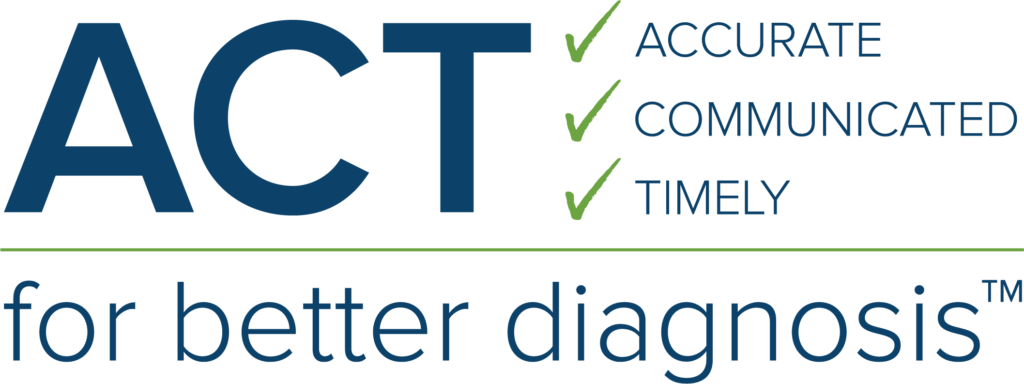New Initiative Launched: ACT for Better DiagnosisTM
On September 13, 2018, ACT for Better Diagnosis was launched at an event at the National Press Club in Washington, DC. ACT for Better Diagnosis is an initiative of the Society to Improve Diagnosis in Medicine (SIDM) and the Coalition to Improve Diagnosis. It aims to improve the diagnostic process by calling on organizations to identify and spread practical steps to better ensure diagnoses are Accurate, Communicated, and Timely.
The name, ACT for Better Diagnosis, was built out of the National Academy of Medicine’s (formerly the Institute of Medicine) definition of diagnostic error as the failure:
- to establish an accurate and timely explanation of the patient’s health problem(s) or
- to communicate that explanation to the patient.
Representatives from the Coalition, representing more than 40 healthcare and patient advocacy organizations, attended the event. Paul Epner, chief executive officer and co-founder of SIDM, made opening remarks, which were followed by a heartbreaking story from Michael Night about his son’s stroke misdiagnosis. Representing the Agency for Healthcare Research and Quality (AHRQ), Gopal Khanna spoke about the importance of working together to achieve more accurate and timely diagnoses.
The event also featured a panel discussion among a variety of voices in the field of diagnostic quality and safety: P. Jeffrey Brady, MD, MPH, director of the Center for Quality Improvement and Patient Safety at AHRQ; Helen Burstin, MD, MPH, FACP, executive vice president and CEO of the Council of Medical Specialty Societies; Amy Friedrich Karnik, MPP, director of Public Policy at WomenHeart; David Mayer, MD, vice president of Quality and Safety at MedStar Health; and Reynold Salerno, PhD, director of the Division of Laboratory Systems at the Center for Disease Control and Prevention. The panel discussion was moderated by New York Times columnist and Yale professor Lisa Sanders, MD, FACP. The discussion was followed by a Q&A session that gave attendees the opportunity to ask questions about the effort. The full event is available via webcast and can be viewed at www.improvediagnosis.org.
Researchers estimate that 40,000-80,000 deaths a year in U.S. hospitals can be attributed to inaccurate or delayed diagnoses. Each year, diagnostic errors affect 12 million adults in outpatient settings and are the most common cause of medical errors reported by patients. “Providing an accurate medical diagnosis is complex and involves uncertainty, but it’s obviously essential to effective and timely treatment,” said Epner. “Nearly everyone will receive an inaccurate diagnosis at some point in their life, and for some the consequences will be grave. Major improvement is needed to systematically identify how to improve diagnostic quality and reduce harm to patients.” Working in collaboration over several months, members of the SIDM-led Coalition identified initial obstacles they believe impede diagnostic accuracy, including:
- Incomplete communication during care transitions. When patients are transferred between facilities, physicians or departments, there is potential for important information to slip through the cracks.
- Lack of measures and feedback. Unlike many other patient safety issues, there are no standardized measures for hospitals, health systems, or physicians to understand their performance in the diagnostic process, to guide improvement efforts or to report diagnostic errors. Providers rarely get feedback that a diagnosis was incorrect or changed.
- Limited support to help with clinical reasoning. With hundreds of potential explanations for any one symptom, clinicians need timely, efficient access to tools and resources to assist in making diagnoses.
- Limited time. Patients and their care providers overwhelmingly report feeling rushed by limited appointment times. That poses real risks to gathering a complete history, which is essential to formulating a working diagnosis, and allows scant opportunity to thoroughly discuss any further steps in the diagnostic process and set appropriate expectations.
- The diagnostic process is complicated. There is limited information available to patients about the questions to ask, whom to notify when changes in their condition occur or what constitutes serious symptoms. It’s also unclear who is responsible for closing the loop on test results and referrals and how to communicate follow-up.
- Lack of funding for research. The impact of inaccurate or delayed diagnoses on healthcare costs and patient harm has not been clearly articulated, and there is a limited amount of published evidence to identify what improves the diagnostic process.
The organizations behind the effort, which represent clinicians, patients, health systems, researchers and testing professionals, acknowledge that improvement will require sustained work over several years with all stakeholders engaged. To see the actions that Coalition member organizations are taking for better diagnosis, visit www.BetterDiagnosis.org.
ACT for Better Diagnosis is supported by the Gordon & Betty Moore Foundation and The Mont Fund. If your organization is interested in joining the Coalition to Improve Diagnosis and the ACT for Better Diagnosis initiative, please email: coalition@improvediagnosis.org.

Every 9 Minutes
Every 9 minutes, someone dies due to a wrong or delayed medical diagnosis.
In this Issue:
Get ImproveDx Delivered to Your Inbox
Don't miss an article. Get the Society to Improve Diagnosis (SIDM)'s newsletter delivered to your inbox.
